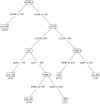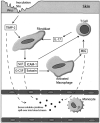Cytokine expression patterns associated with systemic adverse events following smallpox immunization
- PMID: 16845627
- PMCID: PMC1620015
- DOI: 10.1086/505503
Cytokine expression patterns associated with systemic adverse events following smallpox immunization
Abstract
Vaccinia virus is reactogenic in a significant number of vaccinees, with the most common adverse events being fever, lymphadenopathy, and rash. Although the inoculation is given in the skin, these adverse events suggest a robust systemic inflammatory response. To elucidate the cytokine response signature of systemic adverse events, we used a protein microarray technique to precisely quantitate 108 serum cytokines and chemokines in vaccine recipients before and 1 week after primary immunization with Aventis Pasteur smallpox vaccine. We studied 74 individuals after vaccination, of whom 22 experienced a systemic adverse event and 52 did not. The soluble factors most associated with adverse events were selected on the basis of voting among a committee of machine-learning methods and statistical procedures, and the selected cytokines were used to build a final decision-tree model. On the basis of changes in protein expression, we identified 6 cytokines that accurately discriminate between individuals on the basis of adverse event status: granulocyte colony-stimulating factor, stem cell factor, monokine induced by interferon-gamma (CXCL9), intercellular adhesion molecule-1, eotaxin, and tissue inhibitor of metalloproteinases-2. This cytokine signature is characteristic of particular inflammatory response pathways and suggests that the secretion of cytokines by fibroblasts plays a central role in systemic adverse events.
Figures


Similar articles
-
Adverse events after smallpox immunizations are associated with alterations in systemic cytokine levels.J Infect Dis. 2004 Apr 15;189(8):1401-10. doi: 10.1086/382510. Epub 2004 Apr 5. J Infect Dis. 2004. PMID: 15073677 Clinical Trial.
-
Recommendations for using smallpox vaccine in a pre-event vaccination program. Supplemental recommendations of the Advisory Committee on Immunization Practices (ACIP) and the Healthcare Infection Control Practices Advisory Committee (HICPAC).MMWR Recomm Rep. 2003 Apr 4;52(RR-7):1-16. MMWR Recomm Rep. 2003. PMID: 12710832
-
Smallpox vaccination and adverse reactions. Guidance for clinicians.MMWR Recomm Rep. 2003 Feb 21;52(RR-4):1-28. MMWR Recomm Rep. 2003. PMID: 12617510
-
Unintentional transfer of vaccinia virus associated with smallpox vaccines: ACAM2000(®) compared with Dryvax(®).Hum Vaccin Immunother. 2013 Jul;9(7):1489-96. doi: 10.4161/hv.24319. Epub 2013 Apr 9. Hum Vaccin Immunother. 2013. PMID: 23571177 Free PMC article. Review.
-
Cytokine production associated with smallpox vaccine responses.Immunotherapy. 2014;6(10):1097-112. doi: 10.2217/imt.14.72. Immunotherapy. 2014. PMID: 25428648 Free PMC article. Review.
Cited by
-
Safety and immunogenicity of the Pfizer/BioNTech SARS-CoV-2 mRNA third booster vaccine dose against the BA.1 and BA.2 Omicron variants.Med. 2022 Jun 10;3(6):406-421.e4. doi: 10.1016/j.medj.2022.04.013. Epub 2022 Apr 26. Med. 2022. PMID: 35815933 Free PMC article.
-
Human leukocyte antigen genotypes in the genetic control of adaptive immune responses to smallpox vaccine.J Infect Dis. 2011 Jun 1;203(11):1546-55. doi: 10.1093/infdis/jir167. J Infect Dis. 2011. PMID: 21592983 Free PMC article.
-
Involvement of Inflammation and Its Resolution in Disease and Therapeutics.Int J Mol Sci. 2022 Sep 14;23(18):10719. doi: 10.3390/ijms231810719. Int J Mol Sci. 2022. PMID: 36142625 Free PMC article. Review.
-
The first steps towards the era of personalised vaccinology: predicting adverse reactions.Pharmacogenomics J. 2015 Jun;15(3):284-7. doi: 10.1038/tpj.2014.57. Epub 2014 Oct 7. Pharmacogenomics J. 2015. PMID: 25287071 Review.
-
Current Challenges in Vaccinology.Front Immunol. 2020 Jun 25;11:1181. doi: 10.3389/fimmu.2020.01181. eCollection 2020. Front Immunol. 2020. PMID: 32670279 Free PMC article. Review.
References
-
- Ennis FA, Cruz J, Demkowicz WE, Jr, Rothman AL, McClain DJ. Primary induction of human CD8+ cytotoxic T lymphocytes and interferon-gamma-producing T cells after smallpox vaccination. J Infect Dis. 2002;185:1657–9. - PubMed
-
- Rock MT, Yoder SM, Wright PF, Talbot TR, Edwards KM, Crowe JE., Jr Differential regulation of granzyme and perforin in effector and memory T cells following smallpox immunization. J Immunol. 2005;174:3757–64. - PubMed
-
- Rock MT, Yoder SM, Talbot TR, Edwards KM, Crowe JE., Jr Adverse events after smallpox immunizations are associated with alterations in systemic cytokine levels. J Infect Dis. 2004;189:1401–10. - PubMed
-
- Chen R, Lowe L, Wilson JD, et al. Simultaneous quantification of six human cytokines in a single sample using microparticle-based flow cytometric technology. Clin Chem. 1999;45:1693–4. - PubMed
Publication types
MeSH terms
Substances
Grants and funding
LinkOut - more resources
Full Text Sources
Medical
Research Materials

